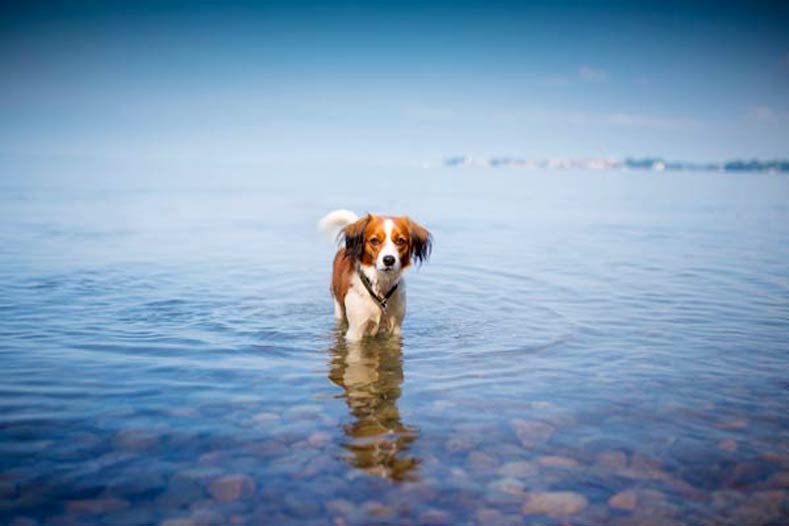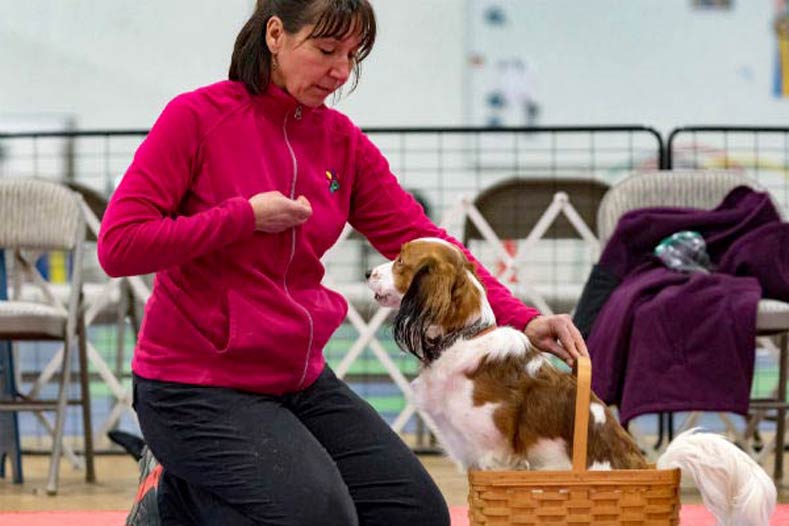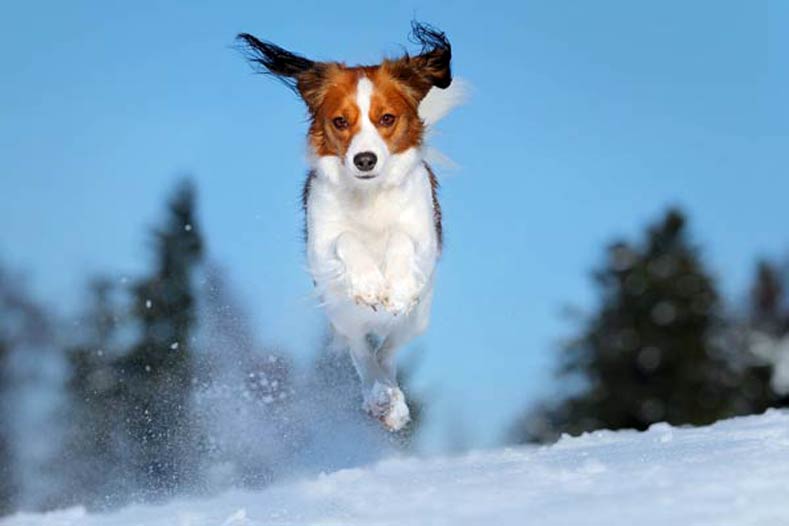
OK, try to pronounce it. I dare you: Nederlandse Kooikerhondje.
But better get used to it because it’s now a member of the American Kennel Club’s companion events family. Which means, you’ll be seeing plenty more of these orange-red, parti-colored characters in the breed ring, Sporting Group, and Best in Show rings, as well as participating in other dog sports, going forward.
And if you’re still stumbling over the pronunciation, those around these small spaniel-type dogs of Dutch ancestry simply refer to them as Kooikers (koy-kers). If you want to give the full name a try, it’s “Coy-ker-hond-tsje.”
In its homeland, the Netherlands, the Kooiker’s job was to lure ducks into a cage, the” kooi,” from where the hunter fetched the ducks and brought them to market. Today, there are still a few kooien operating, where ducks are lured, banded, and released for research.
In the U.S., it is a companion animal, well suited to agility, rally, obedience, barn hunt, dock diving, etc.
Karen Parker, of Black Diamond, Wash., a Kooiker owner since 2014 and vice president of the Kooikerhondje Club of the USA, was attracted to the breed by its size, intelligence, and ease of maintenance. “I was looking for a smaller breed that was playful, energetic, but versatile enough to be a companion/performance dog. Plus, I wanted to introduce a new breed to the agility scene in the Pacific Northwest.”

Previously an owner of Bouvier des Flandres and Australian Shepherds, Parker purchased her first Kooiker with Dutch lines from a Miami breeder. In November, she added a puppy to the mix, this one with Danish ancestry, via an Iowa breeder.
The perky breed, says Parker, makes a good family pet, yet needs plenty of socializing and must know its boundaries. “Basic obedience classes, where all family members are involved, help immensely. They are fun loving, energetic, and happiest being with their people at all times. We have lots of families that like to hike, swim, paddleboard, and kayak with their dogs. Conversely, these dogs love to spend time relaxing at home,” she says.
From an environment standpoint, Kooikers are highly adaptable, Parker emphasizes. “Provided they are given enough exercise and proper stimulation, they can live in apartments and in the suburbs. A large fenced-in area to run is optimal, as they love to hunt, explore, fetch, and run. They need to be mentally challenged, too. Any game where they get to figure out the answer is great fun.
“The breed tends to adjust its activity and energy level – and often its mood – to match that of its human companions. In other words, they are very intuitive to our wants and needs.”
The weight and height parameters go something like this: males: 15-17 inches tall and 24-30 pounds, females: 14-16 inches in height and 20-26 pounds.

The first recorded litter born in the U.S. was in 1999; another stat of note: the breed has been recorded in the Foundation Stock Service since 2004. It joined the AKC’s Miscellaneous Class in July 2016.
Want more?
Here’s a Q&A with Parker about the breed:
Q: What are the chief things breeders focus on in addition to temperament?
A: Health is an utmost priority. Testing for genetic faults involves a simple blood test, which helps with the selection of breeding compatibility. Because our gene pool is still quite small, we are diligent about making certain the breeding coefficients are the best possible. Good structure rounds out the top three. After that, size, coat, and facial expression are additional considerations.
Q: Are there genetic faults associated with the breed?
A: The Kooikerhondje, while a healthy breed, can be genetically prone to Von Willebrand disease (a hereditary clotting disorder that is manifested by abnormal bleeding) and hereditary necrotising myelopathy (a recessive degenerative spinal disease similar to multiple sclerosis in humans). Due to the diligence of Kooiker enthusiasts worldwide, these can be controlled through selective breeding. Testing is available for most problems, and our national club encourages all owners, even pet owners, to submit their dogs’ blood samples for testing, so that we may monitor and evaluate the health of all Kooikerhondjes in the United States. Testing is done at the Utrecht University in the Netherlands, which specializes in Kooikerhondje research.

Q: When you’re at dog shows or out in public with your Kooiker, what are some of the most common questions asked about your breed?
A: “What breed is that?” is usually the No. 1 question. Once we pronounce the name, the second response is “A what?” Then comes “How big does it grow?” “What kind of temperament does it have?” “What can they do?” “Where can I get a puppy?” In other words, they sell themselves.
Q: How much maintenance does the breed require?
A: Kooikers are one of the easiest and most natural of breeds. A simple brushing and nail trim, with an occasional tidy-up of stray hairs around the toes and between the paw pads, is all that is required. Their coat repels dirt, and bathing should be minimal. They are truly no muss, no fuss!
Q: Is there a specific area of the country where there are more Kooiker owners and breeders?

A: The majority of the owners seem to be in the Northeast, but breeders are scattered nationwide. The Kooiker is still considered a rare breed in the U.S., with its registry numbers around 500.
Q: How difficult is this breed to train?
A: It is easy to train. The Kooiker is super smart. It is extremely aware of its environment and doesn’t care much for repetition in exercises, as I have found in agility. Show it once, practice two or three times, and you’re done — in its mind. It begins to question your sanity if you over-drill!
Q: How well do Kooikers integrate into a home with a resident dog or two?
A: I’ve brought mine in as puppies, and they have blended well. They are resource guarders, however, so new owners should address that issue during puppyhood to avoid letting it become a bigger problem in the future. Males seem to be mellower than females. As an aside, the Kooiker is not a good dog-park dog.

Q: What are a few things you would like the general public to know about your breed that has not been promoted previously?
A: They are smart like a Border Collie, but can have a very sharp, terrier-like attitude. They can be very reactive to other dogs, especially while on leash. Socialization with people and respect for other dogs is key with this breed. Despite their “cute” appearance, they are not for the faint of heart and typically not a “first-time” dog. They require a firm but gentle hand in corrections. Once you find the sweet spot, though, they are an absolutely delightful “big dog in a little spaniel suit.”

